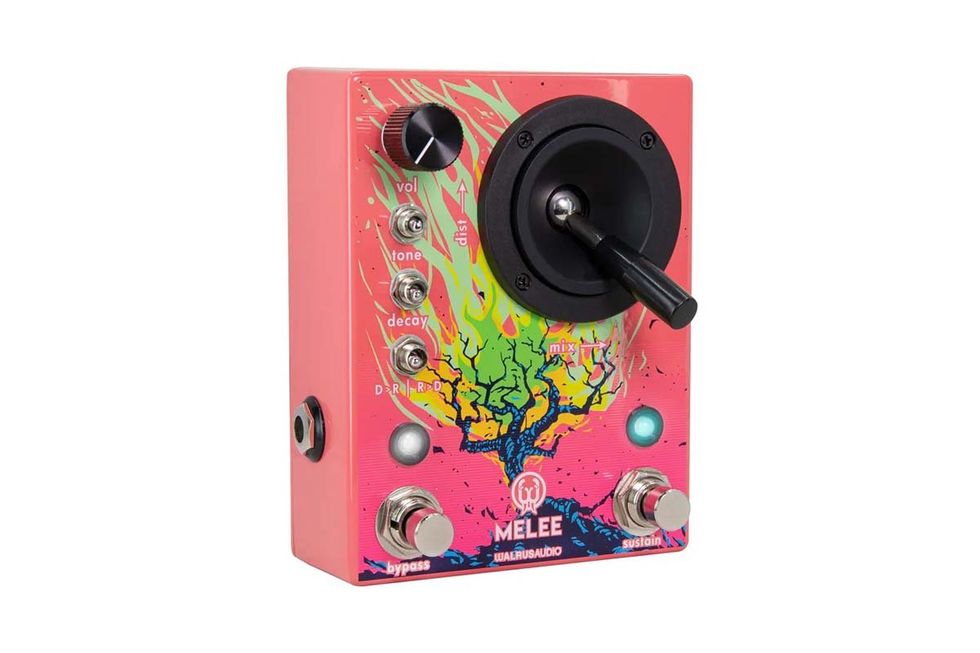Artists have used guitar effects for instruments other than guitar for a long time. And with a joystick taking center stage on the enclosure, Walrus’ Melee, which combines three reverb algorithms and a distortion circuit, looks like it was designed in explicit acknowledgement of that fact. You see, it’s not easy to control a joystick precisely with your foot. So, the presence of the joystick—which blends distortion and reverb in seemingly infinite combinations—makes the pedal seem intended as much for use by synth, laptop, and keyboard artists as guitar players.
That may be true. But even if it were fact, it would do nothing to diminish how cool the Melee is as a pure guitar effect. Melee’s distortion is rich and often old-school fuzzy. Its three reverb algorithms—ambient, octave-down, and reverse reverb with feedback—are awesome, too. And with switches to change effect order, alter decay time, and select EQ emphasis, the tone-shaping options are many. But it’s the joystick that makes the Melee extraordinary and makes it such a deep well of possibilities.
Free-Form Interactions
Walrus’ Melee is far from the first joystick-controlled effect pedal. Walrus already has a dual-joystick fuzz/tremolo in its line in the Janus. A prototype of former Premier Guitar editor Joe Gore’s excellent Filth Fuzz used a joystick before he recognized the perils of fuzz-crazed users stomping it to death. Visionary companies like Devi Ever and Dwarfcraft have also given the joystick a go.
“The distortion is remarkable. It’s articulate and communicates individual string detail clearly, even at high-gain settings.”
Though unorthodox, Melee’s use of a joystick-centered design is a relatively elegant application. The only potentiometer is the master output volume. Situated below the master volume, there are three toggle switches. The topmost toggle controls the tone profile of the pedal—switching between progressively less bright settings. Curiously, the least bright setting is situated in the middle position, and a rotary knob might have been more effective here. Even so, the three EQ voices work well within the context of the fuzz voice. The middle toggle selects the range of reverb decay. It’s essential, given how expansive the Melee’s reverb can sound. And while the longest decay setting is incredibly fun, the shortest decay range can be indispensable at extreme fuzz settings. (The decay switch, by the way, can also be re-purposed to select reverb modulation level by holding down the bypass footswitch.) The third toggle re-orders the reverb and distortion effects, and it vastly expands the Melee’s range of sounds. I love the hazier, more mysterious textures of situating the reverb before distortion. Players that like more precision and control over picking dynamics might prefer the distortion in front.
The already impressive range of sounds afforded by those controls is made exponentially larger thanks to the very sensitive joystick. Pushing the joystick along its vertical axis increases the distortion gain. Moving it from left to right increases the reverb mix. The spaces in between are home to many blends of the two effects, and interacting with the control is a satisfying process akin to shaping clay.
Cross-Pollination Yields Beautiful Fruit
As cool as Walrus’ interface is, it’s only as good as the effects behind it. The distortion is remarkable. It’s articulate and communicates individual string output clearly, even at high-gain settings. But it can also sound searingly fuzz-like—evoking mid-’60s classics like the Fuzz-Tone and Fuzzrite. That combination isn’t easy to find. And Melee’s ability to walk the line between those two worlds is impressive. It’s also critical when working with reverbs as intense as the Melee’s can be.
Each of the Melee’s reverb algorithms is distinct and powerful. The reverse reverb with feedback was a logical launching point for me, given my own My Bloody Valentine predilections. And many settings uncannily evoke MBV sounds—particularly with the joystick in the upper-right quadrant or in the shallower reaches of the upper-left quadrant. Unlike a lot of reverse reverbs, the Melee’s feels fluid and cohesive. Shoegaze devotees would serve themselves well by investigating the Melee for this function alone.
The ambient reverb setting seems mostly free of the cloying high-octave tonalities that can evoke bad TV dramas. Instead, Melee’s ambient reverb setting is more cave-like in its reflections, which meshes nicely with the fuzz at long decay settings, but also creates a nice wash in the trail of heavy fuzz at low decay settings. The octave-down algorithm, meanwhile, will thrill any composer who loves to incorporate doomy, fractured textures as a bed for slow melodic movements. It also delivers treats like haunting, dolorous foghorn tones that sound magnificently terrifying coupled with deep, slow vibrato dives.
The Verdict
Melee is an overflowing source of sound and texture. How well it works for you as a guitar effect depends on your style and mode of performance. Experimental guitarists that work outside the performance constraints of footswitch-activated effects and can situate the Melee on a tabletop, stool, or, heck, a fancy, ceremonial side-stage plinth, will delight in the hands-on nature of the pedal’s interface. More kinetic stage performers may have a hard time avoiding accidental displacement of the joystick.
Melee’s most promising guitar applications probably exist in the realm of non-traditional rock stage presentation and in the studio, where the Melee’s intuitive functionality can be explored more freely. But in any situation where you can make the Melee’s idiosyncratic design work for you, its brilliant fuzzy distortion and varied and expansive reverb voices make it a tone-crafting asset with huge potential.





















